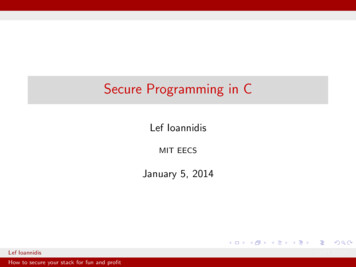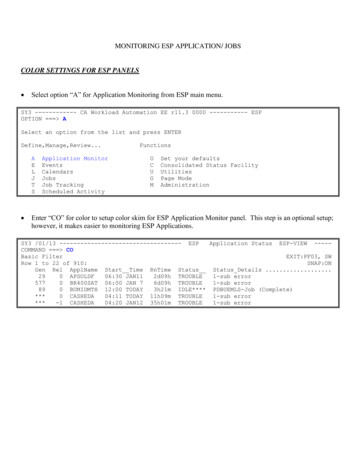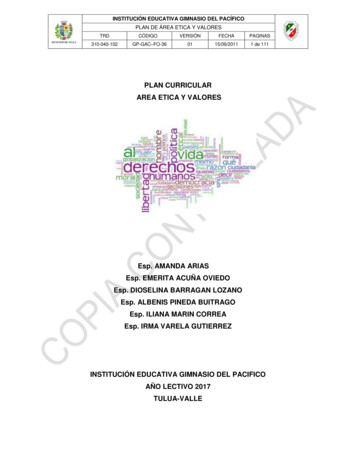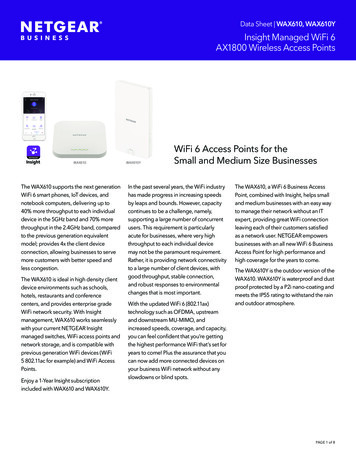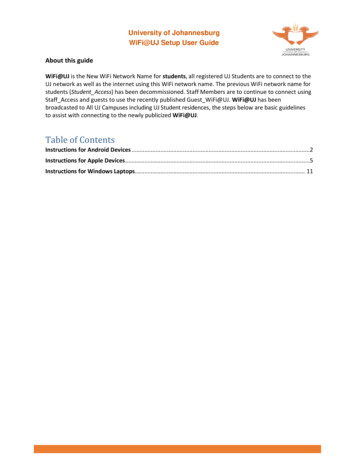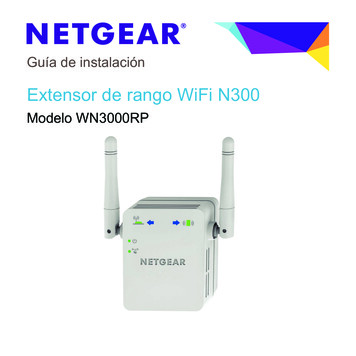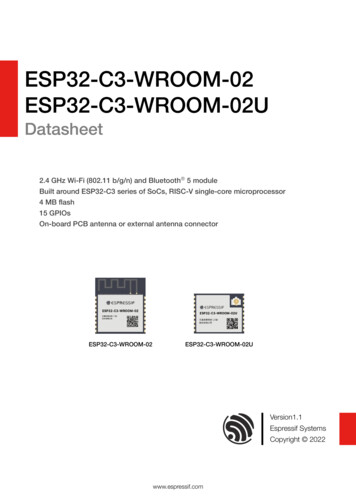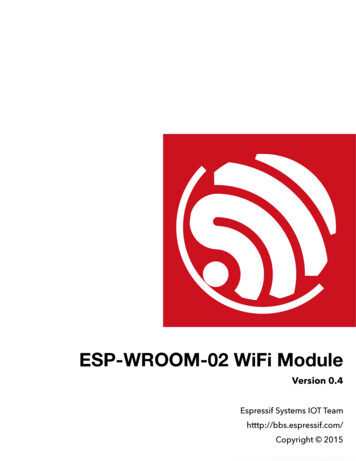
Transcription
ESP-WROOM-02 WiFi ModuleVersion 0.4Espressif Systems IOT Teamhtttp://bbs.espressif.com/Copyright 2015
!!Espressif SystemsESP8266 ESP-WROOM-02 WiFi Module!Disclaimer and Copyright NoticeInformation in this document, including URL references, is subject to change without notice.THIS DOCUMENT IS PROVIDED AS IS WITH NO WARRANTIES WHATSOEVER, INCLUDING ANYWARRANTY OF MERCHANTABILITY, NON-INFRINGEMENT, FITNESS FOR ANY PARTICULARPURPOSE, OR ANY WARRANTY OTHERWISE ARISING OUT OF ANY PROPOSAL, SPECIFICATIONOR SAMPLE. All liability, including liability for infringement of any proprietary rights, relating to useof information in this document is disclaimed. No licenses express or implied, by estoppel orotherwise, to any intellectual property rights are granted herein.The WiFi Alliance Member Logo is a trademark of the WiFi Alliance.All trade names, trademarks and registered trademarks mentioned in this document are property oftheir respective owners, and are hereby acknowledged.Copyright 2015 Espressif Systems. All rights reserved.Espressif Systems2/17Jun 2, 2015
!!Espressif SystemsESP8266 ESP-WROOM-02 WiFi Module!Table of Contents1.Preambles .41.1.Features .51.2.Parameters .62.Pin Descriptions.73.Packaging and Dimension .94.Functional Descriptions .104.1.MCU .104.2.Memory Organization .101.Internal SRAM and ROM .102.External SPI Flash .104.3.Crystal .114.4.Interfaces .124.5.Absolute Maximum Ratings .134.6.Recommended Operating Conditions .134.7.Digital Terminal Characteristics .135.RF Performance .146.Power Consumption .157.Reflow Profile.168.Schematics.17Espressif Systems3/17Jun 2, 2015
!!1.Espressif SystemsESP8266 ESP-WROOM-02 WiFi Module!PreamblesEspressif Systems’ Smart Connectivity Platform (ESCP) is a set of high performance, high integrationwireless SOCs, designed for space and power constrained mobile platform designers. It providesunsurpassed ability to embed Wi-Fi capabilities within other systems, or to function as a standaloneapplication, with the lowest cost, and minimal space requirement.Figure 1 ESP8266EX Block DiagramESP8266EX offers a complete and self-contained Wi-Fi networking solution; it can be used to hostthe application or to offload Wi-Fi networking functions from another application processor.When ESP8266EX hosts the application, it boots up directly from an external flash. In has integratedcache to improve the performance of the system in such applications.Alternately, serving as a Wi-Fi adapter, wireless internet access can be added to any micro controllerbased design with simple connectivity (SPI/SDIO or I2C/UART interface).ESP8266EX is among the most integrated WiFi chip in the industry; it integrates the antennaswitches, RF balun, power amplifier, low noise receive amplifier, filters, power management modules,it requires minimal external circuitry, and the entire solution, including front-end module, is designedto occupy minimal PCB area.ESP8266EX also integrates an enhanced version of Tensilica’s L106 Diamond series 32-bit processor,with on-chip SRAM, besides the Wi-Fi functionalities. ESP8266EX is often integrated with externalsensors and other application specific devices through its GPIOs; codes for such applications areprovided in examples in the SDK.Espressif Systems’ Smart Connectivity Platform (ESCP) demonstrates sophisticated system-levelfeatures include fast sleep/wake context switching for energy-efficient VoIP, adaptive radio biasingEspressif Systems4/17Jun 2, 2015
!!Espressif SystemsESP8266 ESP-WROOM-02 WiFi Module!for low-power operation, advance signal processing, and spur cancellation and radio co-existencefeatures for common cellular, Bluetooth, DDR, LVDS, LCD interference mitigation.1.1.Features 802.11 b/g/n Integrated low power 32-bit MCU Integrated 10-bit ADC Integrated TCP/IP protocol stack Integrated TR switch, balun, LNA, power amplifier and matching network Integrated PLL, regulators, and power management units Supports antenna diversity Wi-Fi 2.4 GHz, support WPA/WPA2 Support STA/AP/STA AP operation modes Support Smart Link Function for both Android and iOS devices SDIO 2.0, (H) SPI, UART, I2C, I2S, IRDA, PWM, GPIO STBC, 1x1 MIMO, 2x1 MIMO A-MPDU & A-MSDU aggregation and 0.4s guard interval Deep sleep power 10uA, Power down leakage current 5uA Wake up and transmit packets in 2ms Standby power consumption of 1.0mW (DTIM3) 20dBm output power in 802.11b mode Operating temperature range -40C 125C FCC, CE, and TELEC certifiedEspressif Systems5/17Jun 2, 2015
!!1.2.Espressif SystemsESP8266 ESP-WROOM-02 WiFi Module!ParametersTable 1 below describes the major parameters.Table 1 ParametersCategoriesWiFi ParametersItemsValuesCertificatesFCC/CE/TELECWiFi Protocles802.11 b/g/nFrequency Range2.4GHz-2.5GHz (2400M-2483.5M)UART/HSPI/I2C/I2S/Ir Remote ControlPeripheral rating Voltage3.0 3.6VOperating CurrentAverage value: 80mAOperating Temperature Range-40 125 Ambient Temperature RangeNormal temperaturePackage Size18mm*20mm*3mmExternal InterfaceN/AWi-Fi modestation/softAP/SoftAP stationSecurityWPA/WPA2EncryptionWEP/TKIP/AESUART Download / OTA (via network) /Firmware Upgradedownload and write firmware via hostSupports Cloud Server Development / SDKSsoftware Developmentfor custom firmware developmentNetwork ProtocolsIPv4, TCP/UDP/HTTP/FTPAT Instruction Set, Cloud Server, Android/iOSUser ConfigurationEspressif SystemsApp6/17Jun 2, 2015
!!2.Espressif SystemsESP8266 ESP-WROOM-02 WiFi Module!Pin DescriptionsThere are altogether 18 pin counts, the definitions of which are described in Table 2 below.Table 2 Pin DescriptionsNO.Pin NameFunction13V32EN3IO14GPIO14; HSPI CLK4IO12GPIO12; HSPI MISO5IO13GPIO13; HSPI MOSI; UART0 CTS6IO15GPIO15; MTDO; HSPICS; UART0 RTS7IO2GPIO2; UART1 TXD8IO0GPIO09GND10IO4GPIO411RXDUART0 RXD; GPIO312TXDUART0 TXD; GPIO113GNDGND14IO5GPIO515RSTReset the module3.3V power supply (VDD)Chip enable pin. Active high.GND16TOUTIt can be used to test the power-supply voltage of VDD3P3 (Pin3 andPin4) and the input power voltage of TOUT (Pin 6). However, these twofunctions cannot be used simultaneously.17IO16GPIO16; can be used to wake up the chipset from deep sleep mode.18GNDGNDNote:Table 3 UART Download ModeTable 4 Flash Boot ighHighEspressif Systems7/17Jun 2, 2015
!!Espressif SystemsESP8266 ESP-WROOM-02 WiFi Module!The following are measured under room temperature conditions with 3.3V and 1.1V power supplies.Table 5 Receiver SensitivityParametersMinInput frequency2412Input impedanceTypicalMaxUnit2484MHz50Input reflectionΩ-10dBOutput power of PA for 72.2Mbps15.516.517.5dBmOutput power of PA for 11b mode19.520.521.5dBmSensitivityDSSS, 1Mbps-98dBmCCK, 11Mbps-91dBm6Mbps (1/2 BPSK)-93dBm54Mbps (3/4 64-QAM)-75dBmHT20, MCS7 (65Mbps, 72.2Mbps)-72dBmAdjacent Channel RejectionOFDM, 6Mbps37dBOFDM, 54Mbps21dBHT20, MCS037dBHT20, MCS720dBEspressif Systems8/17Jun 2, 2015
!!3.Espressif SystemsESP8266 ESP-WROOM-02 WiFi Module!Packaging and DimensionThe external size of the module is 18mm*20mm*3mm, as is illustrated in Figure 2 below. The type offlash integrated in this module is an SPI flash, the capacity of which is 4 MB, and the package size ofwhich is SOP8 150mil. The antenna applied on this module is a 3DBi PCB-on-board antenna.Figure 2 [Module Pin Counts, 18 pin, 18.0 mm x 20.0 mm x 3.0 mm]Figure 3 Top View of ESP-WROOM-02 WiFi ModuleEspressif Systems9/17Jun 2, 2015
!!Espressif SystemsESP8266 ESP-WROOM-02 WiFi Module!Table 6 Dimension of ESP-WROOM-02 WiFi ModuleLengthWidthHeightPAD Size(Bottom)Pin Pitch18mm20mm3mm0.9x1.7mm1.5mmNote: Keep-out Zone is reserved for PCB antenna.4.Functional Descriptions4.1.MCUESP8266EX is embedded with Tensilica L106 32-bit micro controller (MCU), which features extra lowpower consumption and 16-bit RSIC. The CPU clock speed is 80 MHz. It can also reach a maximumvalue of 160 MHz.ESP8266EX is often integrated with external sensors and other specific devices through its GPIOs;codes for such applications are provided in examples in the SDK.4.2.Memory Organization1.Internal SRAM and ROMESP8266EX WiFi SoC is embedded with memory controller, including SRAM and ROM. MCU can visitthe memory units through iBus, dBus, and AHB interfaces. All memory units can be visited uponrequest, while a memory arbiter will decide the running sequence according to the time when theserequests are received by the processor.According to our current version of SDK provided, SRAM space that is available to users is assignedas below: RAM size 50KB, that is to say, when ESP8266EX is working under the station mode and isconnected to the router, programmable space accessible to user in heap and data section isaround 50KB.) There is no programmable ROM in the SoC, therefore, user program must be stored in anexternal SPI flash.2.External SPI FlashThis module is mounted with an 4 MB external SPI flash to store user programs. If larger definablestorage space is required, a SPI flash with larger memory size is preferred. Theoretically speaking, upto 16 MB memory capacity can be supported.Espressif Systems10/17Jun 2, 2015
!!Espressif SystemsESP8266 ESP-WROOM-02 WiFi Module!Suggested SPI Flash memory capacity: OTA is disabled: the minimum flash memory that can be supported is 512 kB; OTA is enabled: the minimum flash memory that can be supported is 1 MB.Several SPI modes can be supported, including Standard SPI, Dual SPI, and Quad SPI.Therefore, please choose the correct SPI mode when you are downloading into the flash, otherwisefirmwares/programs that you downloaded may not work in the right way.4.3.CrystalCurrently, the frequency of crystal oscillators supported include 40MHz, 26MHz and 24MHz. Theaccuracy of crystal oscillators applied should be 10PPM, and the operating temperature rangeshould be between -20 C and 85 C.When using the downloading tools, please remember to select the right crystal oscillator type. Incircuit design, capacitors C1 and C2, which are connected to the earth, are added to the input andoutput terminals of the crystal oscillator respectively. The values of the two capacitors can beflexible, ranging from 6pF to 22pF, however, the specific capacitive values of C1 and C2 depend onfurther testing and adjustment on the overall performance of the whole circuit. Normally, thecapacitive values of C1 and C2 are within 10pF if the crystal oscillator frequency is 26 MHz, while thevalues of C1 and C2 are 10pF C1, C2 22pF if the crystal oscillator frequency is 40 MHz.InterfacePin NameHSPIIO12(MISO)IO13(MOSI)IO14(CLK)IO15(CS)SPI Flash 2, display screen, and MCU can be connected using HSPI interface.PWMIO12(R)IO15(G)IO13(B)Currently the PWM interface has four channels, but users can extend thechannels according to their own needs. PWM interface can be used to controlLED lights, buzzers, relays, electronic machines, and so on.IR RemoteControlIO14(IR T)IO5(IR R)The functionality of Infrared remote control interface can be implemented viasoftware programming. NEC coding, modulation, and demodulation are usedby this interface. The frequency of modulated carrier signal is 38KHz.ADCTOUTESP8266EX integrates a 10-bit analog ADC. It can be used to test the powersupply voltage of VDD3P3 (Pin3 and Pin4) and the input power voltage ofTOUT (Pin 6). However, these two functions cannot be used simultaneously.This interface is typically used in sensor products.I2CIO14(SCL)IO2(SDA)Espressif SystemsDescriptionI2C interface can be used to connect external sensor products and displayscreens, etc.11/17Jun 2, 2015
!!4.4.Espressif SystemsESP8266 ESP-WROOM-02 WiFi Module!InterfacesTable 7 Descriptions of InterfacesInterfacePin NameDescriptionDevices with UART interfaces can be connected with the module.Downloading: U0TXD U0RXD or GPIO2 U0RXDUART0:TXD (U0TXD)UARTRXD (U0RXD)IO15 (RTS)IO13 (CTS)UART1:IO2(TXD)Communicating: UART0: U0TXD, U0RXD, MTDO (U0RTS), MTCK (U0CTS)Debugging: UART1 TXD (GPIO2) can be used to print debugginginformation.By default, UART0 will output some printed information when the device ispowered on and is booting up. If this issue exerts influence on some specificapplications, users can exchange the inner pins of UART when initializing, thatis to say, exchange U0TXD, U0RXD with U0RTS, U0CTS.I2S Input:IO12(I2SI DATA) ;IO13(I2SI BCK );I2SIO14 (I2SI WS); I2S interface is mainly used for collecting, processing, and transmission ofaudio data.I2S Output:IO15(I2SO BCK );IO3(I2SO DATA);IO2 (I2SO WS ).Espressif Systems12/17Jun 2, 2015
!!4.5.Espressif SystemsESP8266 ESP-WROOM-02 WiFi Module!Absolute Maximum RatingsTable 8 Absolute Maximum RatingsRatingValueUnitStorage Temperature-40 to 125 Maximum Soldering Temperature260 3.0 to 3.6VSupply Voltage4.6.ConditionIPC/JEDEC J-STD-020Recommended Operating ConditionsTable 9 Recommended Operating ConditionsOperating ConditionSymbolOperating TemperatureSupply voltage4.7.VDDMinTypMaxUnit-4020125 3.03.33.6VMaxUnitDigital Terminal CharacteristicsTable 10 Digital Terminal CharacteristicsTerminalsSymbolMinTypInput logic level lowVIL-0.30.25VDDVInput logic level highVIH0.75VDDVDD 0.3VOutput logic level lowVOLN0.1VDDVOutput logic level highVOH0.8VDDNVNote: Test conditions: VDD 3.3V, Temperature 20 , if nothing special is stated.Espressif Systems13/17Jun 2, 2015
!!5.Espressif SystemsESP8266 ESP-WROOM-02 WiFi Module!RF PerformanceDescriptionMin.Input frequency2400Input impedanceTyp.MaxUnit2483.5MHz50Input reflectionohm-10dBOutput power of PA for 72.2Mbps15.516.517.5dBmOutput power of PA for 11b mode19.520.521.5dBmSensitivityCCK, 1Mbps-98dBmCCK, 11Mbps-91dBm6Mbps (1/2 BPSK)-93dBm54Mbps (3/4 64-QAM)-75dBmHT20, MCS7 (65Mbps, 72.2Mbps)-72dBmOFDM, 6Mbps37dBOFDM, 54Mbps21dBHT20, MCS037dBHT20, MCS720dBAdjacent Channel RejectionTable 10 RF PerformanceEspressif Systems14/17Jun 2, 2015
!!6.Espressif SystemsESP8266 ESP-WROOM-02 WiFi Module!Power ConsumptionTable 11 Power ConsumptionParametersMinTypicalMaxUnitTx802.11b, CCK 11Mbps, P OUT 17dBm170mATx 802.11g, OFDM 54Mbps, P OUT 15dBm140mATx 802.11n, MCS7, P OUT 13dBm120mARx 802.11b, 1024 bytes packet length , -80dBm50mARx 802.11g, 1024 bytes packet length, -70dBm56mARx 802.11n, 1024 bytes packet length, p-Sleep③10uA①: Modem-Sleep requires the CPU to be working, as in PWM or I2S applications. According to802.11 standards (like U-APSD), it saves power to shut down the Wi-Fi Modem circuit whilemaintaining a Wi-Fi connection with no data transmission. E.g. in DTIM3, to maintain a sleep 300mswake 3ms cycle to receive AP’s Beacon packages, the current is about 15mA.②: During Light-Sleep, the CPU may be suspended in applications like Wi-Fi switch. Without datatransmission, the Wi-Fi Modem circuit can be turned off and CPU suspended to save poweraccording to the 802.11 standard (U-APSD). E.g. in DTIM3, to maintain a sleep 300ms-wake 3mscycle to receive AP’s Beacon packages, the current is about 0.9mA.③: Deep-Sleep does not require Wi-Fi connection to be maintained. For application with long timelags between data transmission, e.g. a temperature sensor that checks the temperature every 100s,sleep 300s and waking up to connect to the AP (taking about 0.3 1s), the overall average current isless than 1mA.Espressif Systems15/17Jun 2, 2015
!!7.Espressif SystemsESP8266 ESP-WROOM-02 WiFi Module!Reflow ProfileTable 12 InstructionsTS max to TL (Ramp-up Rate)3 /second maxPreheatTemperature Min.(TS Min.)Temperature Typical.(TS Typ.)Temperature Min.(TS Max.)Time(TS)150 175 200 60 180 secondsRamp-up rate (TL to TP)3 /second maxTime Maintained Above:--Temperature(TL)/Time(TL)217 /60 150 secondsPeak Temperature(TP)260 max. for 10 secondsTarget Peak Temperature (TP Target)260 0/-5 Time within 5 of actual peak(tP)20 40 secondsTS max to TL (Ramp-down Rate)6 /second maxTune 25 to Peak Temperature (t)8 minutes maxEspressif Systems16/17Jun 2, 2015
!!8.Espressif SystemsESP8266 ESP-WROOM-02 WiFi Module!SchematicsFigure 4 Schematics of ESP-WROOM-02 WiFi ModuleEspressif Systems17/17Jun 2, 2015
According to our current version of SDK provided, SRAM space that is available to users is assigned as below: RAM size 50KB, that is to say, when ESP8266EX is working under the station mode and is connected to the router, programmable space accessible to user in heap and data section is around 50KB.)

